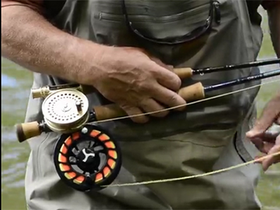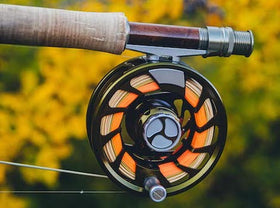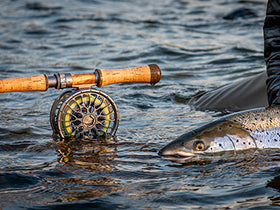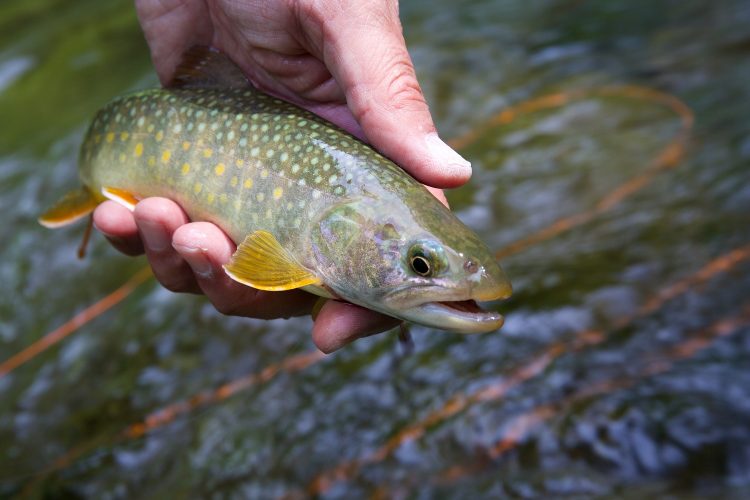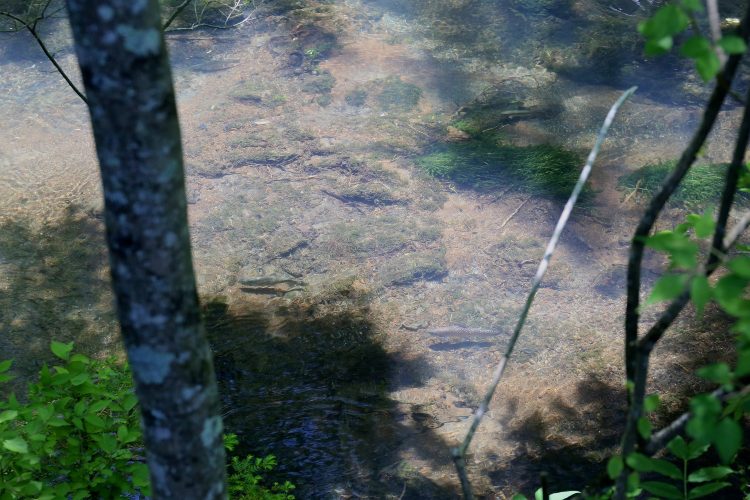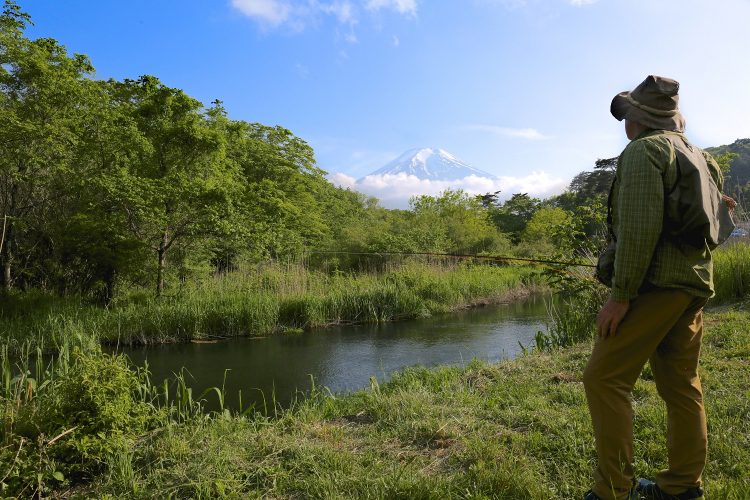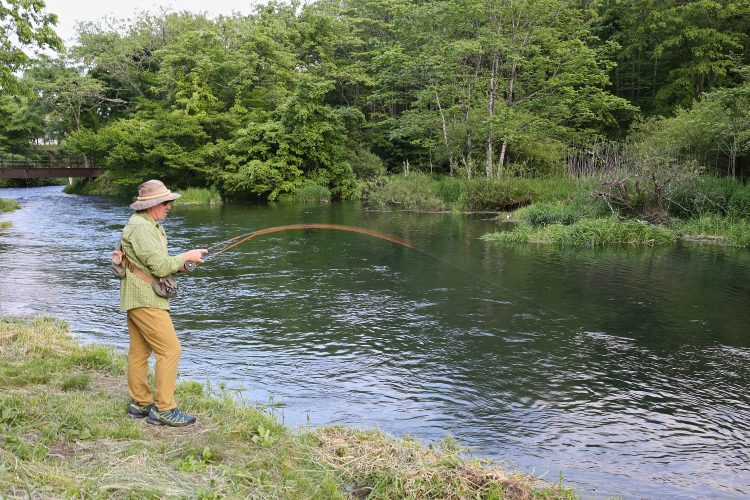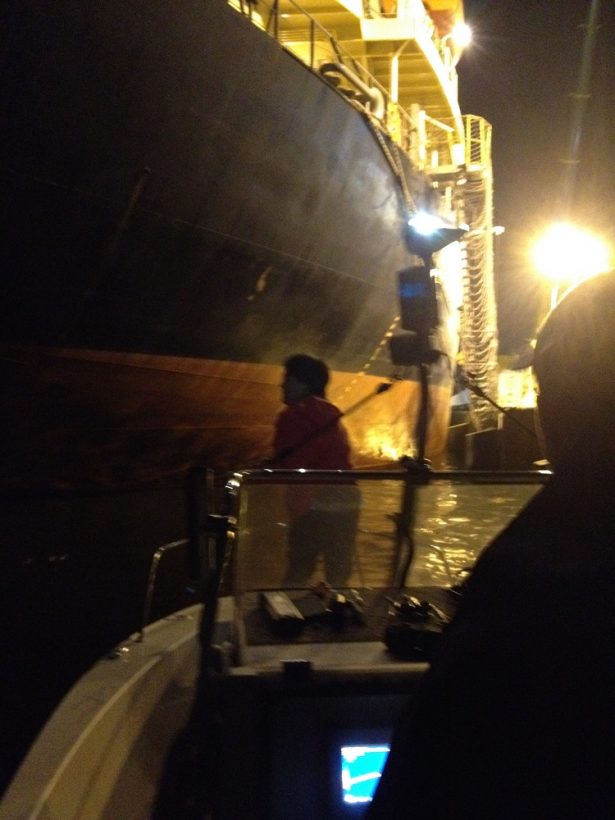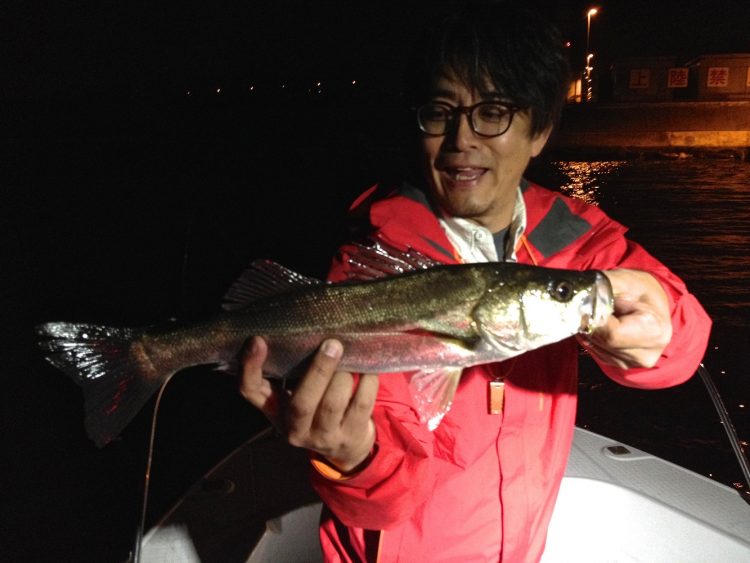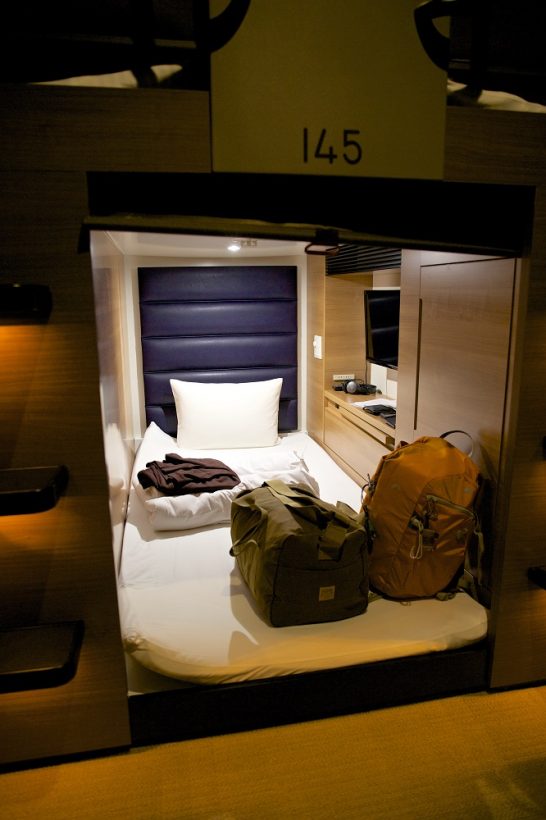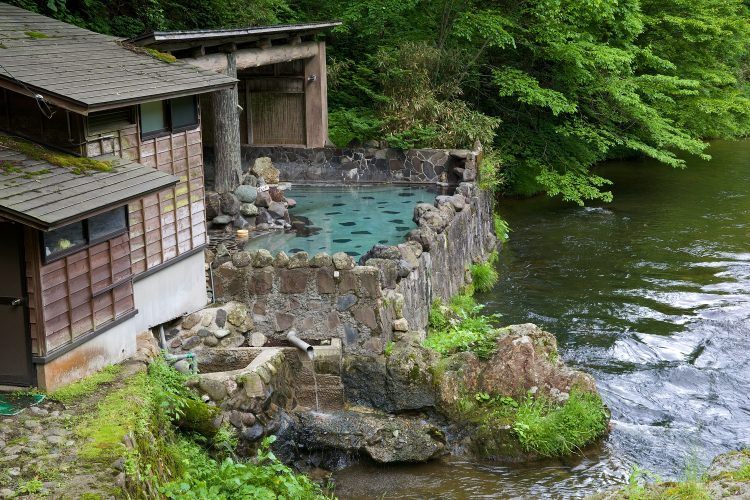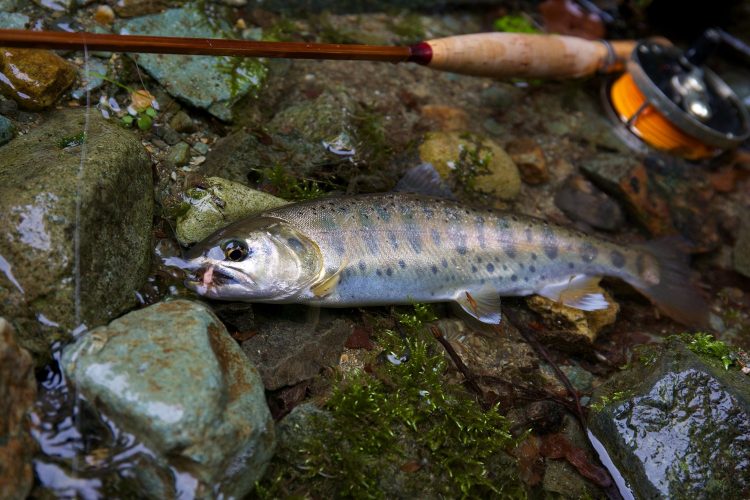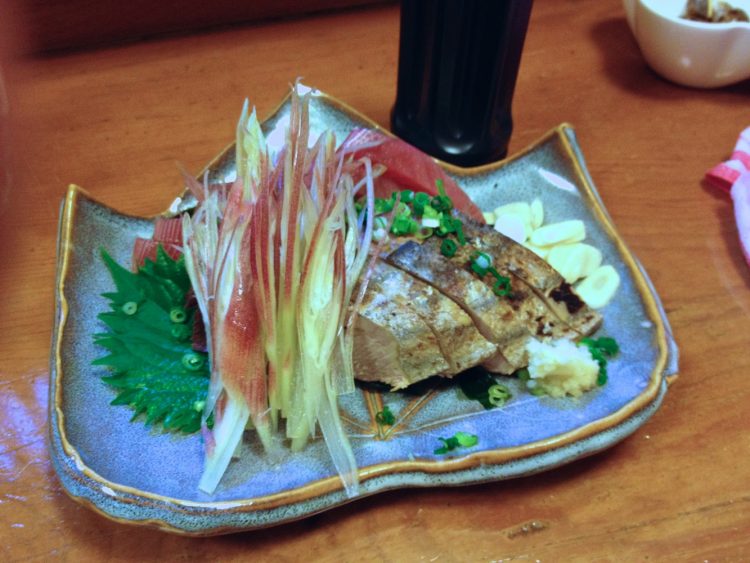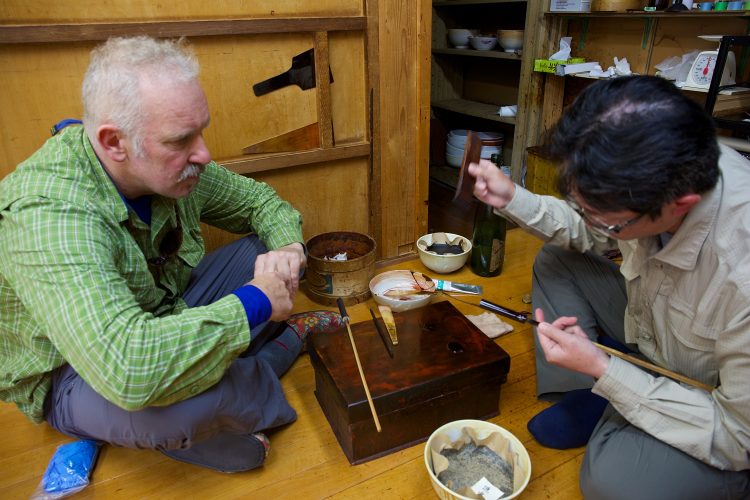
Nick explains why Japan keeps drawing him back.
There are so many reasons why I love Japan, it’s difficult to know where to begin. Before even starting on the fishing, the culture, food, people and scenery are so wonderful it’s worth visiting for those things alone. Somewhat ashamedly though, I struggle to go anywhere without the promise of some fishing being involved. Thankfully for me, I love Japan just for the fishing, so I was eagerly anticipating my visit this May.
Being a bamboo rodmaker, I’m inspired by the uncompromising dedication to quality by Japanese craftspeople: rodmakers and other tackle artisans alike. From what I’ve seen, Japanese fly anglers approach their fishing with the same quality mind set. Their flyfishing is based on Western traditions, and they have a deep respect for the history and culture of flyfishing, but they have developed and refined techniques to an astonishing level to meet the challenges of their fish and streams. (As an aside, Japanese fly anglers don’t view Tenkara as a branch of fly fishing, they see it as an entirely different craft. That’s not to say that Tenkara isn’t an interesting method in its own right. Just don't expect a Japanese fly angler to have any experience with, or interest in, Tenkara)!
The native trout of Japan are beautiful. Yamame (landlocked ‘cherry salmon’, similar to a rainbow trout, but with a chiselled jaw more like a true Pacific salmon), and Iwana (a char, like a brook trout, but with subtle peach and turquoise colouring) have almost nudged brown trout off my ‘favourite fish’ pedestal. These fish are generally small – anything over 12 inches (‘shaku’ – 尺— length) is considered an achievement and cause for celebration. To me, this matters little.
Many Japanese streams are high gradient freestones, fed by mountain snowmelt, running through vivid forests. Further down the valleys, these flatten out to flow through rice fields and other farmland. Both types of water offer a definitively Japanese experience, and I was looking forward to revisiting these streams on my recent trip.
In addition however, my good friend and host, Tomonori ‘Bill’ Higashi, had organised some new experiences for me. My itinerary would take me straight from Tokyo to Oshino, at the foot of Mount Fuji, to experience Japanese spring creek fishing. Then we’d go back to Tokyo for a harbour sea bass session. The third leg of the trip would be to familiar territory in the Prefectures of Iwate and Akita to fish the rural streams I had grown to love on previous adventures. An extra element while in Akita would be for me to learn about traditional Urushi lacquer craft, which some Japanese rodmakers incorporate in finishing their rods.
Oshino
Oshino is a small village at the foot of Mt Fuji. Through it runs a gently flowing, gin-clear spring creek. The stream has an iconic place in Japanese flyfishing, looking like an English chalk stream, with prolific hatches of many mayflies and other insects central to trout fishing lore. It’s a Mecca for Japanese anglers, and popular with a hardcore group of local devotees too (evidenced by the extraordinary number of anglers quietly wandering its banks when we arrived)! To add some international notoriety, in 1981, visiting US President Jimmy Carter caught a large brown trout here.
 We stayed a few days at Oshino at the holiday house of C&F Design owner Kimio Yonenoi, right on the stream.
We stayed a few days at Oshino at the holiday house of C&F Design owner Kimio Yonenoi, right on the stream.Host for our stay was Kimio Yonenoi (President of well known fly box and accessory company, C&F Design), and his wife. C&F has a seminar house right on the banks of the river. It makes an ideal base for R&D on C&F products, and Yonenoi-san seems to take full advantage!
Settling in with a cool drink on the back verandah, it was difficult for me to take my eyes off the stream. Over the sandy bottom, between the gently swaying clumps of weed, I could see fish. Lots of fish. There didn’t seem to be much of a hatch happening, but some moved from side to side taking subsurface food, and occasionally one would rise. Slightly disconcerting for me though, was the constant stream of anglers walking by, watching the water, or stopping to cast. This was in stark contrast to my experience fishing in Akita or Iwate; more like my home turf in Australia, where it’s rare to encounter another angler in a day’s fishing.
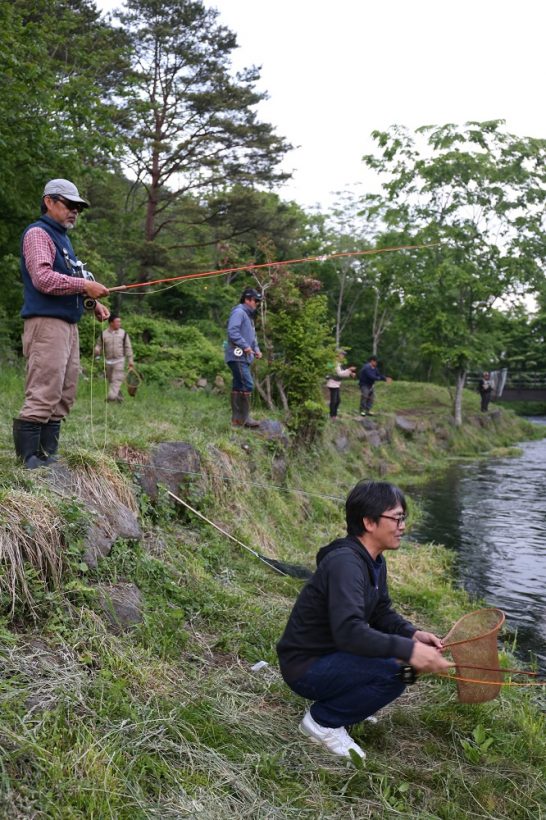 These crowds are an 'Oshino thing', and it’s sort of cool - there are plenty of fish, and you can target one or two and ignore everyone else.
These crowds are an 'Oshino thing', and it’s sort of cool - there are plenty of fish, and you can target one or two and ignore everyone else.In general, the Oshino anglers kept to themselves, but a few who knew Yonenoi-san or Tomonori came up for a chat. Interestingly, most of them were carrying bamboo rods (and a couple were rodmakers themselves). There was no disappointment from our hosts about the number of people on the water. The fish seemed okay about all of this too, and continued to feed unperturbed, despite angler after angler passing by or casting at them. I could see very quickly that these fish were not going to be pushovers!
Asking about the fishery, I learned that it contained a mixture of stocked and wild fish: native Yamame and Iwana, as well as introduced browns, rainbows and brookies. The popular stretch of the river (formed by the junction of the Katsura River and the Shinnasyo River) is less than two kilometres long.
There is no beat system, so anglers are asked to respect the space of others as much as possible. In keeping with Japanese being able to co-exist politely in a very crowded country, this was somehow achieved. Maybe it had something to do with the density of fish numbers and their lack of spooking. I struggled with it at first, but got used to it by the time we left. Once you focused on the fish in front of you, other anglers melted away into your peripheral vision like a passing wombat or echidna. In truth, while there was always someone around the next bend, from time to time there wasn’t an angler in sight.
This might not be the sort of fishing I’m used to, or would want to have as the norm, but I really, really enjoyed it there. When nothing was hatching, the fish were very tough to catch. They might take the odd tiny piece of ‘junk’, but were super-educated about flies and micro-drag. It seemed that both fish and anglers were waiting for a hatch to start! When it did, things swung into action and fish were brought to the net much more regularly. It was fascinating. Yonenoi-san showed me a guidebook written about the stream – an encyclopaedic tome of hatch charts and other information – all for a short stretch of water.
On our last evening at Oshino, we were joined by a couple of local anglers for dinner. It was obvious there was a real depth of thinking in the fishing culture here. I asked if each of them could tell me what they felt was most important to be a good Oshino angler (with Tomonori helping to translate). The first guy said, “Make friends with good anglers, and learn from them”. The second guy said “You have to be here. You can only learn so much from a book. If you wait, the hatches will start and you will catch fish”. Yonenoi-san was last. He said “Watch the water. Look for the hatches and study them. Study everything”. Then he added, “And yes, learn from others. But to receive, you also have to be prepared to give. As a beginner, you might not have much to offer in fishing advice, but you can give in other ways, based on what else you might be good at.” Then the first guy chimed back in “Yes. Maybe I was too hasty in what I said. To make friends with the right people, you need to be a good person yourself. So really, to become a better angler you should first maybe try to become a better person yourself.” What a lovely sentiment.
Tokyo Harbour
Back in Tokyo, Tomonori had organised an evening sea bass session out on Tokyo Harbour. Sea bass are a mainstay for fly anglers. A predatory fish that look a little like a cross between a mulloway and a barramundi, at times they can be caught on top water flies during the day. With recent tides and conditions however, night would be best, with fish holding in the shadows of the wharf-side lights, waiting to ambush baitfish.
We met our guide, Keiichiro Okamoto, of Seakuro Charters, at around 8pm at the wharf in Yokohama. As a landlubber stream angler, I was even more outside my comfort zone than in Oshino, but again, it was a wonderful experience. With the harbour seemingly to ourselves, we fished through until 1am, in the middle of a city of nearly 10 million people. With the backdrop of the lights of Tokyo, we cast flies against wharves, beneath loading container ships (to the angst of the occasional wharf worker), and into churning seawater-cooled factory outflows.
Sea bass hit with the hard jolt of an ambush predator, and we landed half a dozen and lost several more. It was surreal – somehow peaceful and full of suspense at the same time. At one point a massive school of very big mullet started leaping all around us, crashing into the water with huge splashes. They were everywhere – like a Biblical storm of fish. It was so insane I couldn’t stop laughing. Then one flew straight across the bough and crashed into Tomonori, knocking the wind out of him and landing in the bottom of the boat. More cause for laughter, at least for me, as he wiped mullet poo off himself and returned the ‘stunned mullet’ back into the water. At the end of the session, my capsule hotel (another curious but recommended Japanese ‘must do’) was only a 20 minute walk from the wharf through deserted Tokyo streets. I slept well.
We had a lay day before catching the bullet train north to the mountain streams. Tomonori was keen to visit a unique tackle store on the outskirts of Tokyo. Tucked away in a quiet street, is the store: ‘Hirano Tsurigu’ (literally, ‘Hirano’s Fishing Tackle’). Run by a very young Takehashi Hirano, it’s an Aladdin’s Cave of vintage, classic and collectible gear – bamboo rods, old reels, fly boxes – everything you could hope to see and more. I showed great restraint in leaving with my credit card pretty much intact.
Iwate
From Tokyo, we travelled north by bullet train. The fishing was wonderful, catching wild Yamame and Iwana, with several over the ‘shaku’ mark. In Iwate, we based ourselves at the Oosawa Onsen Inn and took to the streams with bamboo rodmaker Kazuaki Kikuchi. The inn is a magnificent old-style Japanese building, overlooking an outdoor onsen (hot spring bath) with a river surrounded by huge Japanese maple trees. Although western-style hotels are available in Japan, it seems more authentic to stay in traditional accommodation, sleeping on a futon rolled out on the tatami mat floor. Coming in after a day’s fishing for a relaxing soak in the onsen is one of the most enjoyable aspects of visiting Japan. The Japanese are genuinely surprised that we don’t do the same thing in Australia!
In Kikuchi-san’s hometown of Morioka, he took us to meet reel maker, Akihro Nakashima. Nakashima-san makes exquisite fly reels in small handcrafted batches. It is a hope of mine to make the work of these craftspeople better known outside of Japan. They deserve wider exposure and we deserve more of their wonderful gear! I had my Jeff Wagner-made reel with me. It was an honour to have Nakashima-san look over Jeff’s reel and comment on the passion and skill that had gone into making it.
Akita
Our final stop on this trip was the adjacent prefecture of Akita. This is the home of bamboo rodmaker and leading developer of the ‘Long Tippet Method’, Naoto Shibuya. I’ve been determined to learn more about this technique since first being exposed to it on my trip to Japan in 2012. It involves using a very long, fine-butt leader (19 to 22 feet), and a deep-actioned rod to achieve astonishing drag-free dry fly drifts in complicated currents.
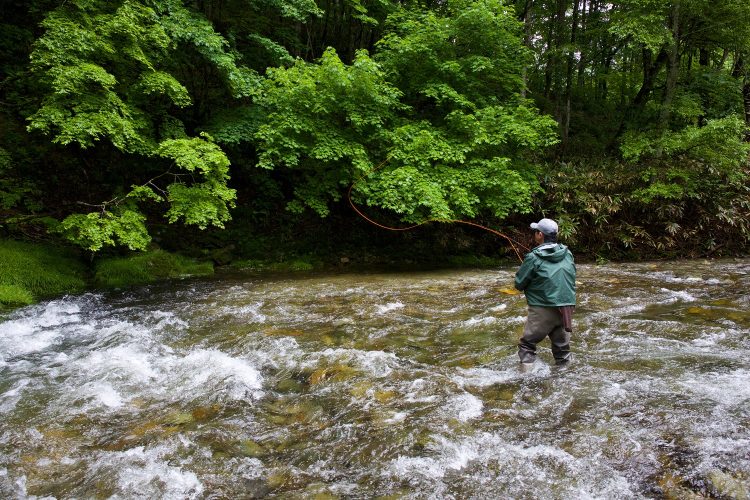 Rodmaker and Urushi lacquer artist Naoto Shibuya. I would pay to go to Japan just to watch him cast and fish.
Rodmaker and Urushi lacquer artist Naoto Shibuya. I would pay to go to Japan just to watch him cast and fish.I’m mesmerised simply by the challenge of learning the technique, as much as for the applications it would have for some of our waters here in Australia and New Zealand. The basics are relatively easy to comprehend, but delivering the fly with pinpoint accuracy and a large amount of controlled slack, is still a work in progress for me. With Shibuya-san’s help, I’m improving. When I have better mastery of it, I hope to share the technique in detail outside of Japan.
The daily ritual in Akita consisted of fishing with Shibuya-san, then stopping off at an Onsen for a relaxing bath, before heading to an Izakaya (bar) for great food, beer, sake and shochu (Japanese vodka).
One night we left dinner a little early, and I thought I was finally getting an early night. But no, we detoured to a Karaoke bar! This was my first experience at Karaoke, and after some mild resistance, I figured ‘when in Rome’, and belted out a few tunes, including ‘Land Down Under’.
The last chapter of the visit was learning a little about traditional Urushi lacquer craft from Shibuya-san. Urushi is the black or coloured finish that you see on items like Japanese bowls and chopsticks. It’s made from the sap of a tree that is related to poison ivy. Many people have a bad allergic reaction to it, so I was a little concerned as well as fascinated as we lacquered some wooden reel seats. I’m happy to report I survived the experience without a single itch, except the itch to try Urushi on some of my own rods.
The more I learn about Japan, the more I love it. I can see that I’ve only scratched the surface of their flyfishing culture and associated crafts. I’ll be back there again as soon as I can, to learn more, have a great time, and maybe even sing a bit more Karaoke!
For more information:
Keiichiro Okamoto, Seakuro Charters
Takehashi Hirano - Hirano Tsurigu
Kazuaki Kikuchi – rodmaker – Big Two Hearted River
Naoto Shibuya – rodmaker, tackle designer, guide, author, Karaoke singer





